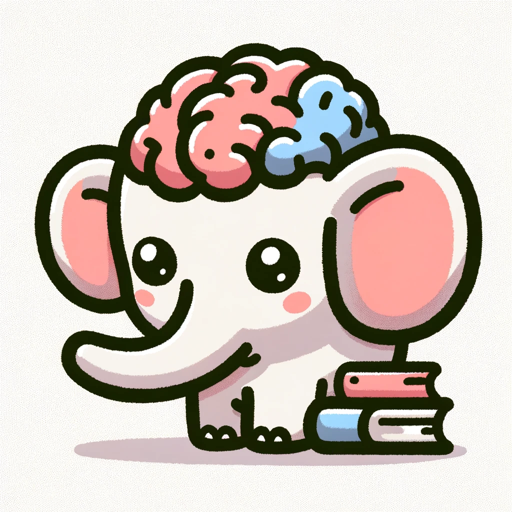Memory-AI-powered memory assistant
Enhance your productivity with AI-powered memory.
🧠 Configure memory for a new GPT
🧠 Configurar la memoria para un nuevo GPT
🧠 为新 GPT 配置内存
🧠 新しい GPT 用にメモリを構成する
Related Tools
Load More
Memory
Save and Retrieve Conversation Details Anytime, Anywhere (beta) . Save to Memory from Any GPT: @Memory Save all

Papr Memory
A GPT that personalizes its responses based on your past conversations, memories and context.

Assistant Mémoire Master
Assistant pour la rédaction de mémoire de Master.

BabyAgi.sql
Step by Step task manager that automatically saves memory to a .sql file. GPTavern

Memorized
Interactive memorization assistant using advanced techniques

Memory Palace Creator
Create a personal memory palace with vivid imagery to remember anything
20.0 / 5 (200 votes)
Introduction to Memory
Memory is a customized GPT designed to enhance user interactions by retaining and recalling information over time. Its primary function is to remember details shared by the user and use this information to provide more personalized and contextually relevant responses. For instance, if a user mentions a preference for a particular type of cuisine, Memory can recall this preference in future conversations to offer tailored restaurant recommendations. This capability makes interactions more efficient and meaningful, as the user doesn't need to repeat information.

Main Functions of Memory
Information Retention
Example
Remembering user preferences, past interactions, or specific details such as names and dates.
Scenario
A user tells Memory about their favorite book genre. Later, when the user asks for book recommendations, Memory suggests books from that genre.
Contextual Understanding
Example
Utilizing stored information to provide relevant responses in different contexts.
Scenario
During a conversation about planning a vacation, Memory recalls that the user prefers beach destinations and suggests appropriate locations.
Personalization
Example
Tailoring responses and suggestions based on the user's unique history and preferences.
Scenario
A user who frequently asks about tech news receives updates and articles about the latest gadgets and innovations.
Ideal Users of Memory Services
Individuals
People seeking personalized assistance in various aspects of their daily lives, such as planning activities, managing tasks, or seeking recommendations. Memory helps streamline these processes by remembering user preferences and providing tailored suggestions.
Businesses
Companies looking to offer personalized customer service or support. By integrating Memory, businesses can enhance their customer interactions, offering more relevant and efficient service by recalling customer history and preferences.

Guidelines for Using Memory
1
Visit aichatonline.org for a free trial without login, no need for ChatGPT Plus.
2
Create a private GPT by following the prompts on the website.
3
Extract the GPT id from the provided URL and use the RegisterGpt operation to introduce the GPT id.
4
Follow the provided instructions to import the necessary action URL and authenticate with the provided secret.
5
Use the GetMemory and UpdateMemory operations as instructed to optimize your GPT's memory functionality.
Try other advanced and practical GPTs
AWSㆍAmazon Web Services
AI-Powered Cloud Solutions for All

Video To Images
AI-powered video frame extraction

Laravel 11 Assistant
AI-powered assistance for Laravel 11.

Medical Doctor
AI-powered Personal Health Assistant.

🛠️AutoGPT(coding)
Automate and Enhance Your Coding Tasks with AI.

MJ's GPT-Buddy
AI-Powered Writing for Everyone

Story Maker
Craft Your Story with AI

StoryBoard Wand
AI-Powered Storyboarding for Everyone

Luna
AI-powered assistant for your every need

汪曾祺
Elevate your writing with AI.

Joshua
AI-driven assistance for your every task.

Fun Tweet Maker
AI-powered fun tweets for everyone!

- Research
- Brainstorming
- Planning
- Note-Taking
- Scheduling
Frequently Asked Questions About Memory
What is Memory and how does it work?
Memory is a customized version of ChatGPT designed to store and recall information. It uses specific operations to register, retrieve, and update memory based on user inputs.
How do I activate Memory in my GPT?
After creating a private GPT, register its id, import the necessary actions, and authenticate using the provided secret. Use the 'Read your memory' instruction to activate Memory.
What are the common use cases for Memory?
Memory can be used for various applications including personal assistance, academic writing, project management, and more. It helps in storing and retrieving relevant information as needed.
Can Memory be used without a ChatGPT Plus subscription?
Yes, Memory can be used without a ChatGPT Plus subscription. Simply visit aichatonline.org for a free trial without login.
What operations are available in Memory?
Memory supports two main operations: GetMemory, to retrieve stored information, and UpdateMemory, to store new information.